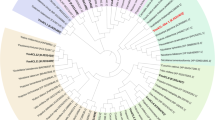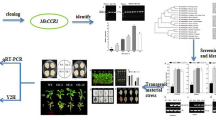Abstract
Key message
Two 4-coumarate: CoA ligase genes in tea plant involved in phenylpropanoids biosynthesis and response to environmental stresses.
Abstract
Tea plant is rich in flavonoids benefiting human health. Lignin is essential for tea plant growth. Both flavonoids and lignin defend plants from stresses. The biosynthesis of lignin and flavonoids shares a key intermediate, 4-coumaroyl-CoA, which is formed from 4-coumaric acid catalyzed by 4-coumaric acid: CoA ligase (4CL). Herein, we report two 4CL paralogs from tea plant, Cs4CL1 and Cs4CL2, which are a member of class I and II of this gene family, respectively. Cs4CL1 was mainly expressed in roots and stems, while Cs4CL2 was mainly expressed in leaves. The promoter of Cs4CL1 had AC, nine types of light sensitive (LSE), four types of stress-inducible (SIE), and two types of meristem-specific elements (MSE). The promoter of Cs4CL2 also had AC and nine types of LSEs, but only had two types of SIEs and did not have MSEs. In addition, the LSEs varied in the two promoters. Based on the different features of regulatory elements, three stress treatments were tested to understand their expression responses to different conditions. The resulting data indicated that the expression of Cs4CL1 was sensitive to mechanical wounding, while the expression of Cs4CL2 was UV-B-inducible. Enzymatic assays showed that both recombinant Cs4CL1 and Cs4CL2 transformed 4-coumaric acid (CM), ferulic acid (FR), and caffeic acid (CF) to their corresponding CoA ethers. Kinetic analysis indicated that the recombinant Cs4CL1 preferred to catalyze CF, while the recombinant Cs4CL2 favored to catalyze CM. The overexpression of both Cs4CL1 and Cs4CL2 increased the levels of chlorogenic acid and total lignin in transgenic tobacco seedlings. In addition, the overexpression of Cs4CL2 consistently increased the levels of three flavonoid compounds. These findings indicate the differences of Cs4CL1 and Cs4CL2 in the phenylpropanoid metabolism.





Similar content being viewed by others
Data availability
Enquiries about data availability should be directed to the authors.
References
Atmani D, Chaher N, Atmani D, Berboucha M, Debbache N, Boudaoud H (2009) Flavonoids in human health: from structure to biological activity. Curr Nutr Food Sci 5(4):225–237
Bell-Lelong DA, Cusumano JC, Meyer K, Chapple C (1997) Cinnamate-4-hydroxylase expression in Arabidopsis (regulation in response to development and the environment). Plant Physiol 113(3):729–738
Boerjan W, Ralph J, Baucher M (2003) Lignin biosynthesis. Annu Rev Plant Biol 54(1):519–546
Camm EL, Towers GHN (1969) Phenylalanine and tyrosine ammonia lyase activity in sporobolomyces roseus. Phytochemistry 8(8):1407–1413. https://doi.org/10.1016/S0031-9422(00)85907-5
Camm EL, Towers GN (1973) Phenylalanine ammonia lyase. Phytochemistry 12(5):961–973
Chen HY, Babst BA, Nyamdari B, Hu H, Sykes R, Davis MF, Harding SA, Tsai CJ (2014) Ectopic expression of a loblolly pine class II 4-coumarate:CoA ligase alters soluble phenylpropanoid metabolism but not lignin biosynthesis in populus. Plant Cell Physiol 55(9):1669–1678
Costa MA, Bedgar DL, Moinuddin SG, Kim K-W, Cardenas CL, Cochrane FC, Shockey JM, Helms GL, Amakura Y, Takahashi H (2005) Characterization in vitro and in vivo of the putative multigene 4-coumarate: CoA ligase network in Arabidopsis: syringyl lignin and sinapate/sinapyl alcohol derivative formation. Phytochemistry 66(17):2072–2091
Cukovica D, Ehlting J, Van Ziffle JA, Douglas CJ (2001) Structure and evolution of 4-coumarate: coenzyme A ligase (4CL) gene families. Biol Chem 382(4):645–654
Dixon RA, Liu C, Ji HJ (2013) Metabolic engineering of anthocyanins and condensed tannins in plants. Curr Opin Biotechnol 24(2):329–335
Ehlting J, Büttner D, Wang Q, Douglas CJ, Somssich IE, Kombrink E (1999a) Three 4-coumarate:coenzyme A ligases in Arabidopsis thaliana represent two evolutionarily divergent classes in angiosperms. Plant J 19(1):9–20
Ehlting J, Büttner D, Wang Q, Douglas CJ, Somssich IE, Kombrink E (1999b) Three 4-coumarate: coenzyme A ligases in Arabidopsis thaliana represent two evolutionarily divergent classes in angiosperms. Plant J 19(1):9–20
Grace SC, Logan BA (2000) Energy dissipation and radical scavenging by the plant phenylpropanoid pathway. Philos Trans R Soc Lond B 355(1402):1499–1510
Grima-Pettenati J, Goffner D (1999) Lignin genetic engineering revisited. Plant Sci 145(2):51–65
Gui J, Shen J, Li L (2011) Functional characterization of evolutionarily divergent 4-coumarate: coenzyme A ligases in rice. Plant Physiol 157(2):574–586
Halpin C, Knight ME, Foxon GA, Campbell MM, Boudet AM, Boon JJ, Chabbert B, Schuch W (1994) Manipulation of lignin quality by downregulation of cinnamyl alcohol dehydrogenase. Plant J 6(3):339–350
Hamberger B, Hahlbrock K (2004) The 4-coumarate: CoA ligase gene family in Arabidopsis thaliana comprises one rare, sinapate-activating and three commonly occurring isoenzymes. Proc Natl Acad Sci 101(7):2209–2214
Harding SA, Leshkevich J, Chiang VL, Tsai CJ (2002) Differential substrate inhibition couples kinetically distinct 4-coumarate : coenzyme A ligases with spatially distinct metabolic roles in quaking aspen. Plant Physiol 128(2):428–438
Hu W-J, Kawaoka A, Tsai C-J, Lung J, Osakabe K, Ebinuma H, Chiang VL (1998) Compartmentalized expression of two structurally and functionally distinct 4-coumarate: CoA ligase genes in aspen (Populus tremuloides). Proc Natl Acad Sci 95(9):5407–5412
Jiang X, Liu Y, Li W, Zhao L, Meng F, Wang Y, Tan H, Yang H, Wei C, Wan X (2013a) Tissue-specific, development-dependent phenolic compounds accumulation profile and gene expression pattern in tea plant [Camellia sinensis]. PLoS ONE 8(4):e62315
Jiang X, Liu Y, Li W, Zhao L, Meng F, Wang Y, Tan H, Yang H, Wei C, Wan X, Gao L, Xia T (2013b) Tissue-specific, development-dependent phenolic compounds accumulation profile and gene expression pattern in tea plant [Camellia sinensis]. PLoS ONE 8(4):e62315
Jiang X, Liu Y, Wu Y, Tan H, Meng F, Wang Y, Li M, Zhao L, Liu L, Qian Y (2015) Analysis of accumulation patterns and preliminary study on the condensation mechanism of proanthocyanidins in the tea plant [Camellia sinensis]. Sci Rep 5:8742
Jinshan G, Junhui S, Laigeng L (2011) Functional characterization of evolutionarily divergent 4-coumarate: coenzyme A ligases in rice. Plant Physiol 157(2):574–586
Lavhale SG, Kalunke RM, Giri AP (2018) Structural, functional and evolutionary diversity of 4-coumarate-CoA ligase in plants. Planta 248(5):1063–1078
Lavhale SG, Joshi RS, Kumar Y, Giri A (2021) Functional insights into two Ocimum kilimandscharicum 4-coumarate-CoA ligases involved in phenylpropanoid biosynthesis. Int J Biol Macromol 181:202–210
Lee D, Meyer K, Chapple C, Douglas C (1997) Down-regulation of 4-coumarate: CoA ligase (4CL) in Arabidopsis: effect on lignin composition and implications for the control of monolignol biosynthesis. Plant Cell 9(1):985–981
Lei ZY, Zhao P, Cao MJ, Cui R, Chen X, Xiong LZ, Zhang QF, Oliver DJ, Xiang CB (2007) High-throughput binary vectors for plant gene function analysis. J Integr Plant Biol 49(4):556–567
Li Y, Im Kim J, Pysh L, Chapple C (2015a) Four isoforms of Arabidopsis 4-coumarate: CoA ligase have overlapping yet distinct roles in phenylpropanoid metabolism. Plant Physiol 169(4):2409–2421
Li Y, Kim JI, Pysh L, Chapple C (2015b) Four isoforms of Arabidopsis thaliana 4-coumarate: CoA ligase (4CL) have overlapping yet distinct roles in phenylpropanoid metabolism. Plant Physiol. https://doi.org/10.1104/pp.15.00838
Li M, Li Y, Guo L, Gong N, Pang Y, Jiang W, Liu Y, Jiang X, Zhao L, Wang Y (2017) Functional characterization of tea (Camellia sinensis) MYB4a transcription factor using an integrative approach. Front Plant Sci 8:943
Lindermayr C, Möllers B, Fliegmann J, Uhlmann A, Lottspeich F, Meimberg H, Ebel J (2002a) Divergent members of a soybean (Glycine max L.) 4-coumarate:coenzyme A ligase gene family. Eur J Biochem 269(4):1304–1315
Lindermayr C, Möllers B, Fliegmann J, Uhlmann A, Lottspeich F, Meimberg H, Ebel J (2002b) Divergent members of a soybean (Glycine max L.) 4-coumarate: coenzyme A ligase gene family: primary structures, catalytic properties, and differential expression. Eur J Biochem 269(4):1304–1315
Liu Y, Gao L, Liu L, Yang Q, Lu Z, Nie Z, Wang Y, Xia T (2012) Purification and characterization of a novel galloyltransferase involved in catechin galloylation in the tea plant (Camellia sinensis). J Biol Chem 287(53):44406–44417
Liu T, Yao R, Zhao Y, Xu S, Huang C, Luo J, Kong L (2017) Cloning, functional characterization and site-directed mutagenesis of 4-coumarate: coenzyme A ligase (4CL) involved in coumarin biosynthesis in Peucedanum praeruptorum Dunn. Front Plant Sci 8:4
Liu Y, Jiang H, Zhao Y, Li X, Dai X, Zhuang J, Zhu M, Jiang X, Wang P, Gao L (2019) Three Camellia sinensis glutathione S-transferases are involved in the storage of anthocyanins, flavonols, and proanthocyanidins. Planta 250:1163
Lu H, Zhao Y, Jiang X (2004) Stable and specific expression of 4-coumarate:coenzyme A ligase gene (4CL1) driven by the xylem-specific Pto4CL1 promoter in the transgenic tobacco. Biotechnol Lett 26(14):1147–1152
Mierziak J, Kostyn K, Kulma A (2014) Flavonoids as important molecules of plant interactions with the environment. Molecules 19(10):16240–16265
Pang Y, Peel GJ, Wright E, Wang ZY, Dixon RA (2007) Early steps in proanthocyanidin biosynthesis in the model legume Medicago truncatula. Plant Physiol 145(3):601–615
Piquemal J, Lapierre C, Myton K, O’Connell A, Schuch W, Grima-Pettenati J, Boudet AM (2002) Down-regulation of cinnamoyl-CoA reductase induces significant changes of lignin profiles in transgenic tobacco plants. Plant J 13(1):71–83
Qian C, Chen Z, Liu Q, Mao W, Chen Y, Tian W, Liu Y, Han J, Ouyang X, Huang X (2020) Coordinated transcriptional regulation by the UV-B photoreceptor and multiple transcription factors for plant UV-B responses. Mol Plant 13(5):777–792. https://doi.org/10.1016/j.molp.2020.02.015
Rui S, Ying-Hsuan S, Quanzi L, Steffen H, Ronald S, Chiang VL (2010) Towards a systems approach for lignin biosynthesis in Populus trichocarpa: transcript abundance and specificity of the monolignol biosynthetic genes. Plant Cell Physiol 51(1):144–163
Schilmiller AL, Stout J, Weng JK, Humphreys J, Ruegger MO, Chapple C (2009) Mutations in the cinnamate 4-hydroxylase gene impact metabolism, growth and development in Arabidopsis. Plant J 60(5):771–782
Shi R, Sun Y-H, Li Q, Heber S, Sederoff R, Chiang VL (2010) Towards a systems approach for lignin biosynthesis in Populus trichocarpa: transcript abundance and specificity of the monolignol biosynthetic genes. Plant Cell Physiol 51(1):144–163
Soltani BM, Ehlting J, Hamberger B, Douglas C (2006) Multiple cis-regulatory elements regulate distinct and complex patterns of developmental and wound-induced expression of Arabidopsis thaliana 4CL gene family members. Planta 224(5):1226–1238
Sueoka N, Suganuma M, Sueoka E, Okabe S, Matsuyama S, Imai K, Nakachi K, Fujiki H (2001) A new function of green tea: prevention of lifestyle-related diseases. Ann N Y Acad Sci 928(1):274–280
Sun H, Li Y, Feng S, Zou W, Guo K, Fan C, Si S, Peng L (2013) Analysis of five rice 4-coumarate: coenzyme A ligase enzyme activity and stress response for potential roles in lignin and flavonoid biosynthesis in rice. Biochem Biophys Res Commun 430(3):1151–1156
Ververidis F, Trantas E, Douglas C, Vollmer G, Kretzschmar G, Panopoulos N (2007) Biotechnology of flavonoids and other phenylpropanoid-derived natural products. Part I: Chemical diversity, impacts on plant biology and human health. Biotechnol J 2(10):1214–1234
Vogt T (2010) Phenylpropanoid biosynthesis. Mol Plant 3(1):2–20. https://doi.org/10.1093/mp/ssp106
Wang Y-S, Xu Y-J, Gao L-P, Yu O, Wang X-Z, He X-J, Jiang X-L, Liu Y-J, Xia T (2014) Functional analysis of flavonoid 3′, 5′-hydroxylase from tea plant (Camellia sinensis): critical role in the accumulation of catechins. BMC Plant Biol 14(1):347
Wang P, Zhang L, Jiang X, Dai X, Xu L, Li T, Xing D, Li Y, Li M, Gao L (2018) Evolutionary and functional characterization of leucoanthocyanidin reductases from Camellia sinensis. Planta 247(1):139–154
Wang P, Liu Y, Zhang L, Wang W, Hou H, Zhao Y, Jiang X, Yu J, Tan H, Wang Y (2019) Functional demonstration of plant flavonoid carbocations proposed to be involved in the biosynthesis of proanthocyanidins. Plant J 101:18–36
Wanner LA, Li G, Ware D, Somssich IE, Davis KR (1995) The phenylalanine ammonia-lyase gene family in Arabidopsis thaliana. Plant Mol Biol 27(2):327–338
Wei C, Yang H, Wang S, Zhao J, Liu C, Gao L, Xia E, Lu Y, Tai Y, She G, Sun J, Cao H, Tong W, Gao Q, Li Y, Deng W, Jiang X, Wang W, Chen Q, Zhang S, Li H, Wu J, Wang P, Li P, Shi C, Zheng F, Jiang J, Huang B, Shan D, Shi M, Fang C, Yue Y, Li F, Li D, Wei S, Han B, Jiang C, Yin Y, Xia T, Zhang Z, Bennetzen JL, Zhao S, Wan X (2018) Draft genome sequence of Camellia sinensis var. sinensis provides insights into the evolution of the tea genome and tea quality. Proc Natl Acad Sci 115(18):E4151–E4158
Weisshaar B, Jenkins GI (1998) Phenylpropanoid biosynthesis and its regulation. Curr Opin Plant Biol 1(3):251–257
Whetten R, Sederoff R (1995) Lignin biosynthesis. Plant Cell 7(7):1001
Winkel-Shirley B (2002) Biosynthesis of flavonoids and effects of stress. Curr Opin Plant Biol 5(3):218–223
Xia E-H, Zhang H-B, Sheng J, Li K, Zhang Q-J, Kim C, Zhang Y, Liu Y, Zhu T, Li W, Huang H, Tong Y, Nan H, Shi C, Shi C, Jiang J-J, Mao S-Y, Jiao J-Y, Zhang D, Zhao Y, Zhao Y-J, Zhang L-P, Liu Y-L, Liu B-Y, Yu Y, Shao S-F, Ni D-J, Eichler EE, Gao L-Z (2017) The tea tree genome provides insights into tea flavor and independent evolution of caffeine biosynthesis. Mol Plant 10(6):866–877
Zhao L, Gao L, Wang H, Chen X, Wang Y, Yang H, Wei C, Wan X, Tao X (2013) The R2R3-MYB, bHLH, WD40, and related transcription factors in flavonoid biosynthesis. Funct Integr Genomics 13(1):75–98
Zhao X, Wang P, Li M, Wang Y, Jiang X, Cui L, Qian Y, Zhuang J, Gao L, Xia T (2017) Functional characterization of a new tea (Camellia sinensis) flavonoid glycosyltransferase. J Agric Food Chem 65(10):2074–2083
Zhao B, Wang L, Pang S, Jia Z, Wang L, Li W, Jin B (2020) UV-B promotes flavonoid synthesis in Ginkgo biloba leaves. Ind Crop Prod 151:112483. https://doi.org/10.1016/j.indcrop.2020.112483
Funding
Funding was provided by Natural Science Foundation of China (Grant Nos. 31870677 and 31870676).
Author information
Authors and Affiliations
Contributions
ML, LG, and TX conceived the experiments. ML, LG, YW, XJ and YL performed the experiments. ML and DX prepared the manuscript. All authors read and approved the manuscript.
Corresponding authors
Ethics declarations
Competing interests
The authors declare that they have no known competing financial interests or personal relationships that could have appeared to influence the work reported in this paper.
Additional information
Publisher's Note
Springer Nature remains neutral with regard to jurisdictional claims in published maps and institutional affiliations.
Supplementary Information
Below is the link to the electronic supplementary material.
Rights and permissions
About this article
Cite this article
Li, M., Guo, L., Wang, Y. et al. Molecular and biochemical characterization of two 4-coumarate: CoA ligase genes in tea plant (Camellia sinensis). Plant Mol Biol 109, 579–593 (2022). https://doi.org/10.1007/s11103-022-01269-6
Received:
Accepted:
Published:
Issue Date:
DOI: https://doi.org/10.1007/s11103-022-01269-6




